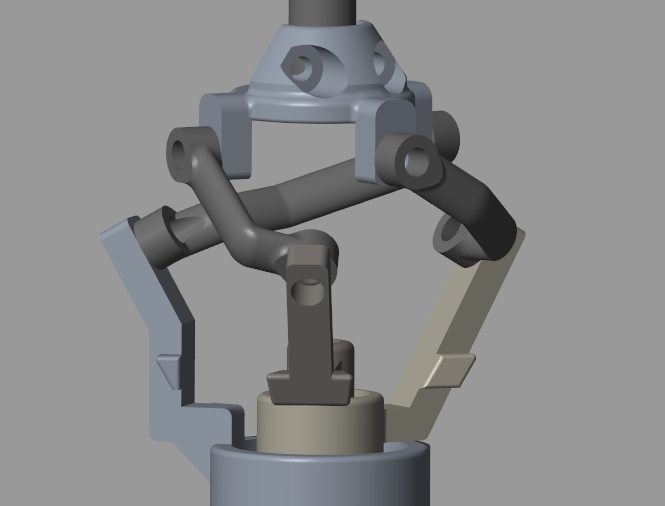Wrist Mk2: the Mathematics of the spherical joint

Wrist Mk2
It seems impossible to find the analytic solution in the closed form of the direct geometric problem (i.e. given the motor angles, find the orientation of the platform), but it is quite easy to calculate the analytic form of the inverse Jacobian if we express the problem in a smart way. The numeric solution of the direct geometric problem is quite easy as well.
Premise
- The platform rotates without translation around the origin \(O\).
- The length of the arms, equal to the platform radius, is normalized as 1.
- Let's call \(q_i\) the positions of the joints on the platform and \(p_i\) the positions of the joints in the arms.
- The "L" shape of the connecting rods forces each vector \(q_i\) to be always orthogonal to its respective vector \(p_i\) in all configurations.
- The euclidean distance \(L\) between the \(q_i\) and the respective \(p_i\) is imposed to be constant by the connecting rod.
- In the case of symmetrical structure, the coordinates of the platform joints in the rest configuration are \(q_1=(1,0,0)\), \(q_2=(-\frac{1}{2},\frac{\sqrt{3}}{2},0)\) and \(q_3=(-\frac{1}{2},-\frac{\sqrt{3}}{2},0)\)
- The coordinates of the arm joints, that rotate around the vertical axis, are \(p_1=(\cos{\theta_1},\sin{\theta_1},-h)\), \(p_2=(\cos{\theta_2},\sin{\theta_2},-h)\) and \(p_3=(\cos{\theta_3},\sin{\theta_3},-h)\) with \(h\) constant and with \(\theta_i\) = rotations of the three motors. In the case of symmetrical structure, at rest we have \(\theta_1=60^\circ\), \(\theta_2=180^\circ\) and \(\theta_3=240^\circ\).
- The above numbers are referred to the left employment of the wrist mechanism. In order to use it in the right configuration, an offset of \(180^\circ\) must be added so that the whole mechanism kinematics will result symmetrically reflected, maintaining the meaning of roll, pitch, and yaw under the chosen convention. Thus, at rest, the arm angles will be \(\theta_1=240^\circ\), \(\theta_2=0^\circ\) and \(\theta_3=60^\circ\). This implies that the rest position must be set by properly calibrating the arm position sensors on the software side, while the hand interface must be rotated by \(180^\circ\) with respect to the platform on the hardware side.
Analytic inverse Jacobian
The distance between the platform joints and the arm joints remains constant during the motion:
and thus
From the above equation we have
but \(\dot{q_i}=\omega\times q_i\) where \(\omega\) = angular velocity vector of the platform. By substituting this relation in the previous equation we obtain:
because the second term \(q_i\cdot(\omega\times q_i)\) is null due to the scalar triple product of coplanar vectors.
\(p_i\) rotates around the vertical axis, thus its angular velocity is \(\dot{p_i}=(e_z\dot{\theta_i})\times p_i\). Let's substitute this relation into the equation above, obtaining:
but \(p_i\cdot(e_z\times p_i)=0\) thanks to the scalar triple product of coplanar vectors, so it remains:
from which we can obtain
By applying the cyclical permutation of the scalar triple product and the anticommutativity of the cross product we obtain at last:
We can see that this is just the inverse Jacobian by rewriting the three equations in matrix form:
Singularity occurs when one of the three divisors \((q_i\times p_i)\cdot e_z\) is null, i.e., when the joint \(q_i\) lies in the same vertical plane that contains the origin and the joint \(p_i\).
From the inverse Jacobian, we can obtain the transposed direct Jacobian by numeric inversion, required to project the torque acting on the end effector backward to the motors. Given an algebraic three-vector of angular velocities Roll, Pitch and Yaw, the geometric angular velocity vector \(\omega\) is obtained by the known Jacobian transformation from algebraic to geometric representation:
Direct geometric problem (numeric solution)
In order to solve the direct geometric problem with an iterative numeric algorithm we build a dynamic system by substituting to the connecting rods with virtual springs with equal length at rest \(L\) sempre attached to the arm joints at points \(p_i\) and to the platform joints at points \(q_i\). The force exerted by each virtual spring is:
For simplicity, and in order to obtain more rapid and precise convergence, we use a nonlinear (quadratic) spring law:
The total torque applied to the platform is:
We also assume that the momentum of inertia of the platform is negligible with respect to the viscous friction, so that we have a first order law of motion \(\omega=k\tau\). In this way, given the position of the arms, by iterating until convergence we arrive in the correspondant platform orientation by small finite rotations starting from a tentative initial configuration.
- At runtime, we use as initial configuration the orientation obtained in the previous control cycle, so that we are sure to be starting from a configuration close to the real one.
- If no variations occured in the encoder readings, there is no need for any calculation.
- For better numeric stability it is better to represent internally the platform orientation with a quaternion, normalizing it periodically.
The algorithm can always find a solution if the gap between two arms is less that 180 deg. This is taken into account by the inverse geometrical problem solver, so that it never produces motor angle targets that lead to such singularities.
Algorithm backtraking
The direct geometric problem solver uses variable gradient descent step and backtracking in order to improve performance by reducing the steps required to converge, as well as to improve robustness.
It works in this way: - The gradient descent step \(S\) is initialized to \(S_{max}\), and the YPR configuration is initialized with that calculated in the previous control cycle, which should be close to the new solution. - If the algorithm can't converge (singularity), then it performs backtracking to the last good YPR configuration, divides the step by 2, and continues. - If the step runs below \(S_{min}\), then a reinitialization to the known position (0,0,0) takes place, and the step is reinitialized to \(S_{max}\).